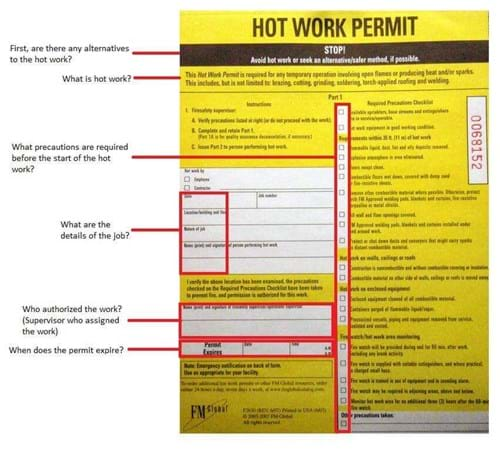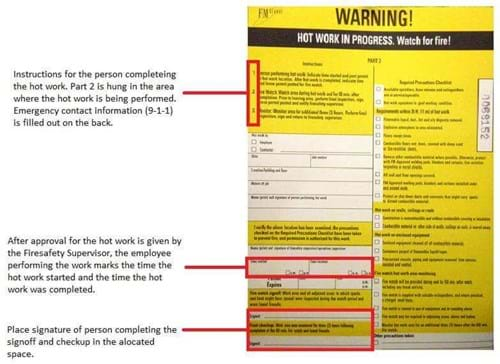Document Type:
Exhibit Number: 6.01ii
Effective: 10-28-13
Revised:
Legal References:
HOT WORK PERMIT
To establish precautions which should be followed prior to any hot work operation, and to provide procedures for using hot work permits. A valid, authorized, Hot Work Permit is required for each hot work operation performed in City owned and operated facilities by employees, contractors or their subcontractors. The person responsible (Firesafety Supervisor) for the completion of the hot work shall ensure that all Hot Work Permit requirements are satisfied.
General Rules for Permits
• Hot work may not be performed when a fire protection system is not operational or is impaired. In the event of a sprinkler system impairment during work, the area supervisor or contractor must be notified to cease hot work operations until the impairment can be corrected.
• Permits must not be issued for work areas that cannot be made fire safe.
• A permit is not required for designated fire-safe areas where hot work operations are routinely conducted and proper fire safeguards are already in place.
• Additional training on hot work can be found at https://fmglobaltraining.skillport.com.
Hot Work Permit – Work Instructions
The Hot Work Permit procedure is as follows:
1. Prior to start of any hot work operation, the Firesafety Supervisor must personally examine the work area to confirm that the following minimum precautions have been taken:
• Hot work equipment inspected and in good working condition.
• The equipment or material to be worked on is thoroughly cleaned of all deposits of oil, carbon, dust, or other combustible/flammable residues.
• Whenever possible, the hot work operation should be moved to a designated hot work area Shop, to minimize the risk of fire in the facility.
• Sprinklers, where provided, are in commission and will not be taken out of service while this work is being done.
• All combustibles materials have been located at least 35 feet from the operation and any combustible materials that cannot be moved, protected with metal guards or flameproof covers (i.e. fire-resistant tarpaulins).
• The work will be confined to the area or equipment specified on the permit.
• Surrounding floors have been swept clean and, if combustible, wet down.
• Ample portable extinguishing equipment has been provided and is easily accessible ( i.e. extinguishers are not from the immediate area, but are additional ones).
• Exhaust and return air fans (HVAC) within 35 feet have been turned off.
• All floor, wall, and ceiling openings within 35 feet of the operation have been tightly covered to prevent sparks or slag from entering an unobserved area.
• Hot work areas must be isolated with tape, barricades, or traffic horses to warn personnel from walking into and under this area when work is in progress and divert them from hazards.
• Compressed oxygen is not to be used under any circumstances for the purpose of ventilation, comfort, cooling, blowing dust from clothes, or for cleaning the work area.
2. In order for a Hot Work Permit to be valid, it must be signed and issued by the Firesafety Supervisor.
3. The Firesafety Supervisor will review all appropriate emergency procedures.
4. The Firesafety Supervisor signs the permit, removes Part 1 and gives Part 1a and Part 2 to the person doing the work who must post it in a visible location in the hot work area. The original copy of Part 1 will be kept by the Firesafety Supervisor until the job is complete.
5. The person performing the hot work will indicate the start and stop times on part 2.
6. During and after hot work, the following work rules must be implemented:
• Fire watch will be provided during and for 60 minutes after work, including any coffee or lunch breaks.
• Fire watch person is supplied with a suitable fire extinguisher and properly trained in use of fire extinguisher and activation of the nearest local fire alarm.
• The hot work area and all adjacent area (including floors above and below) must be monitored periodically for 3 hours after the work has been completed. When hot work is performed on or near a wall, check the other side of the wall because there is a chance that heat was transferred or radiated through the wall.
• The Fire watch person must sign off on Part 2 of the permit confirming fire watch is completed.
7. Upon completion of the work, the Firesafety Supervisor will conduct a final inspection of the area and sign off on Part 2 of permit only if the area is fire- safe.
8. Collect both copies of the permit for documentation purposes. Copies of old permits should be kept on file in the Hot Work Permit file.

